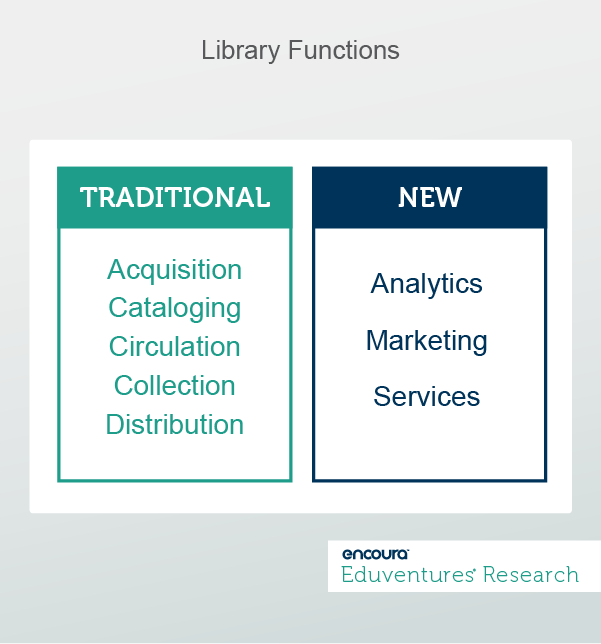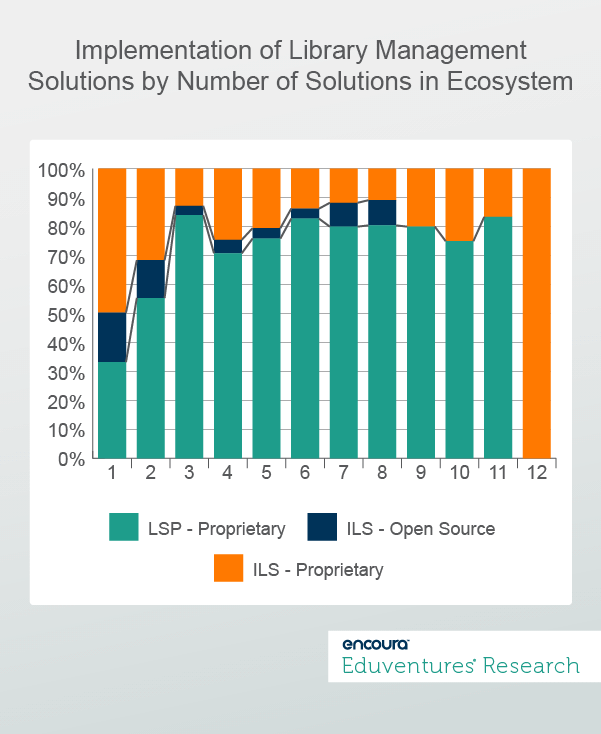What can college and university leaders learn from the world of library management solutions? More than you might think.
All institutional leaders struggle with choosing the right technology to help their teams perform their tasks. Often they must decide between a single solution that promises to deliver on all functionality—an enterprise resource planning (ERP) solution, for example—or several point solutions specifically designed for each individual function. The latter is complicated by issues of integration, ecosystem management, and the challenge of responding to changing requirements.
Our recent report, Market Analysis: Library Management Solutions, explores how the world of library management solutions—one of the new additions to our 2019 Higher Education Technology Landscape (Landscape)—solves for this, with lessons for leaders across the university.
Changing World of Library Management
To see how libraries navigate this question, we need to first understand the world of library management today. In some respects, not much has changed. This world still mirrors our college memories of searching through card catalogs for books, finding them among a dusty maze of bookshelves, and then checking them out. In other words, we remember the “traditional” functions of a library.
In intervening years, however, additional functions—analytics, marketing, and services—have been added, which we call “new” functions (see Figure 1):

This "new" category of library functions may seem foreign to many of us, but it is something on which libraries focus. Librarians, for example, now want to know how the library is engaging students, faculty, and staff (analytics), and how best to promote their collections (marketing). Likewise, as students seek greater on-demand access to materials, libraries have had to provide things like self-service checkout (services).
Until the mid-1970s, libraries performed these traditional functions by leveraging disparate systems, but that changed with the origin of integrated library systems (ILS), which aimed to merge these functions into a unified solution.
Over time, however, the demand for libraries to provide digital content grew. This demand exposed limitations with the ILS, which focused on performing traditional functions with print materials. This demand impacted library technology in two ways: the rise in technologies that stored and searched digital content, and the need to overcome the ILS’ challenges in integrating with these other technologies.
Beginning in the 2000s, a new solution came into existence—the library services platform (LSP)—that aimed to deliver much of the functionality provided by other technologies, provide the new library functions, and enable integration with other library-related technology.
Impact of the Changing World on Selection of Library Management Solutions
on the selection of library management technology are twofold:- Crowded ecosystems: As shown in Figure 2, despite the role of the LSP and ILS as a set of solutions that aims to merge the functionality of other library-related solutions, institutions still have crowded ecosystems. In fact, our research shows that most libraries in higher education have three or more library-related solutions, which suggests that institutions still see the ILS and LSP as part of an overall ecosystem and not as the single solution to address all traditional and new library functions.
- Integration requirements: As mentioned, one of the main functions of the LSP is to enable integration with other library-related technologies, which would suggest that there should be a direct relationship between the number of library-related technologies in a library’s ecosystem and LSP implementation.
Figure 2 also shows that there is a close correlation between the number of these technologies and LSP implementation, which indicates that the requirement for integration with other technologies is a significant factor in decision-making about which type of Library Management Solution (ILS or LSP) to acquire.

This data demonstrates that library technology leaders appear to answer the “one vs. many” solution with an awareness that this requires the integration of multiple solutions, the management of a complex technological ecosystem, and a commitment to respond to a changing set of requirements. These leaders recognize that, no matter which solutions they choose, they will still have a crowded ecosystem and will need their library management tools to integrate with other solutions.
The Bottom Line
So, is there anything that we can learn from this, something that applies to technology acquisition more broadly? We believe the answer is “yes.” Technology leaders across the institutions should keep in mind that the best technology choices may not always come down to “one vs. many”; the best path forward could be a combination of the two. Despite their broad functionality promises, some single solutions may still need to co-exist within a crowded ecosystem, and may require extensive integration with other solutions.
Likewise, while this crowded library ecosystem might appear to be daunting in terms of its complexity, it may also allow institutions to adapt to changing requirements. Like library technology leaders, therefore, leaders in other technological areas across the institutions should look beyond a single solution vs. point solution decision point, and determine whether the acquisition of any solution helps their ecosystems support the growth and evolution of their institutions.

Never
Miss Your
Wake-Up Call
Learn more about our team of expert research analysts here.
Eduventures Principal Analyst at ACT | NRCCUA
Contact
Join us in Boston, June 3-5, 2020, as we convene eminent thinkers, leaders, and practitioners from across the higher education spectrum to examine and showcase the best ideas, old and new. If there is one event in higher ed you attend in 2020, make it Eduventures Summit.

